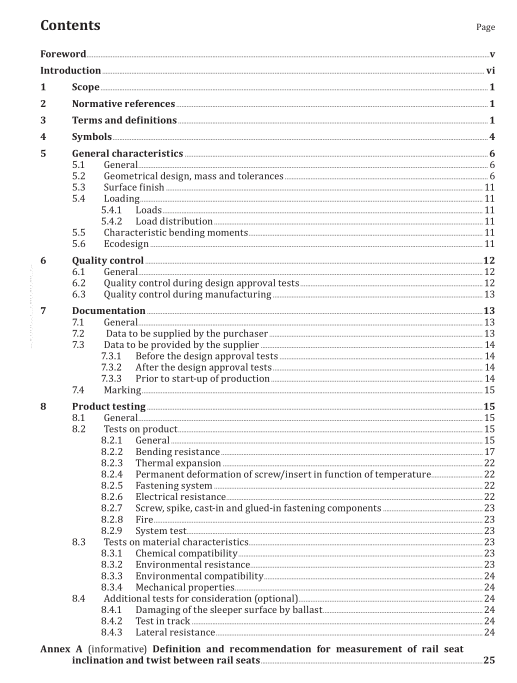ISO 12856-3:2022 pdf download.Railway applications — Polymeric composite sleepers, bearers and transoms — Part 3: General requirements
5.3? Surface? finish
Particular attention shall be paid to the rail seat area, which shall be free of any individual large void.
The purchaser shall specify the permissible size, shape and number of voids.
5.4 Loading
5.4.1 Loads
The track is subjected to repeated loads in three different directions, generally applied simultaneously:
a) vertical loads from axle load and service conditions;
b) transverse loads from guiding forces;
c) longitudinal loads from acceleration and braking, thermal stresses in continuous welded rail, etc.
Under all loading conditions the track shall retain its geometry including gauge, top, level and alignment.
The characteristic load is calculated by applying a dynamic coefficient to the static wheel load.
The dynamic coefficient takes into account the normal dynamic effects of wheel and track irregularities.
Loads and the corresponding bending moments are the responsibility of the purchaser.
5.4.2 Load distribution
The assembled rail, fastening system and polymeric composite sleepers, bearers and transoms on ballast or other support shall be considered as a beam on a continuous elastic support.
The moment of inertia of the rail profile, the spacing of the polymeric composite sleepers, bearers and transoms, and the elasticity of the whole assembly on its support have an influence on the longitudinal distribution of the vertical wheel loads applied on the rail. As a result, the rail seat load applied on the polymeric composite element is only a proportion of the wheel load.
5.5 Characteristic bending moments
The characteristic bending moments shall be determined according to the design criteria for the polymeric composite sleeper, bearer and transom. They are used to calculate test loads.
For the determination of characteristic bending moments, see Annex B for ballasted track and Annex C for transoms.
NOTE The method proposed in Annex B is also used for polymeric composite sleepers, bearers or transoms on elastic layers in ballastless track.
5.6 Ecodesign
The supplier and/or manufacturer of polymeric composite sleepers, bearers or transoms shall assess the environmental factors of its products.
The following topics shall be highlighted:
a) use of hazardous components, including percentage of mass;
b) use of recycled materials, including percentage of mass;
c) declaration of energy needed for production (type and quantity), gas emission and other environmental aspects, related to 1 kg of goods;
d) recycling ways and opportunities, including process description, percentage of mass and energy need;
e) declaration of transports at each level, from raw materials to customer’s border: type of transport, quantity of material.
6 Quality control
6.1 General
The supplier and/or manufacturer shall operate a quality system, which is defined and maintained in a quality manual. This manual shall address all actions, functions and resources, procedures and practices concerned with achieving and providing documentary evidence that the quality of the delivered polymeric composite sleepers, bearers and transoms and services that the supplier provides are to the agreed requirements.
The quality manual shall include a quality plan for the production of polymeric composite sleepers, bearers and transoms, which defines and details the following:
a) the organization, structure and responsibilities;
b) all the materials, processes and procedures for manufacturing, storing and transporting the polymeric composite sleepers, bearers and transoms;
c) all testing requirements, including definition of testing equipment, method of testing, frequency of tests, etc.;
d) all other quality control procedures to ensure and verify that the polymeric composite sleepers,bearers and transoms and services provided are to the agreed requirements of the purchaser.
The purchaser shall have access to the quality manual at the premises of the supplier and/or manufacturer.
NOTE Guidance on quality systems is given in the ISO 9000 family of standards.
Changes to the design, materials or production process from that used to produce the sleepers used in design approval testing shall not be introduced without prior approval from the purchaser. The purchaser may require the repetition of the design approval tests described in this document before approving the changes mentioned above.
6.2 Quality control during design approval tests
The supplier shall provide to the purchaser all quality documents in relation to the polymeric composite elements to be submitted to design approval tests.
This includes:
a) detailed drawings of the polymeric composite element and components included;
b) material data sheet for the product;ISO 12856-3 pdf download.ISO 12856-3 pdf download
